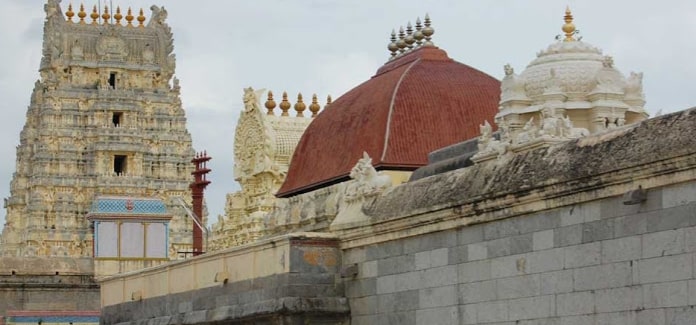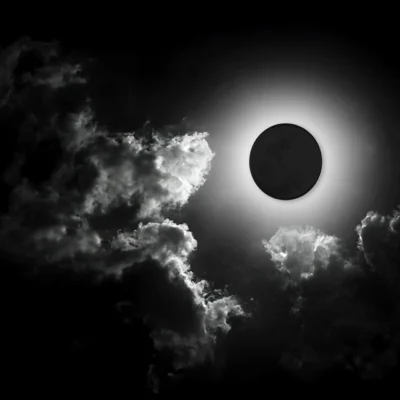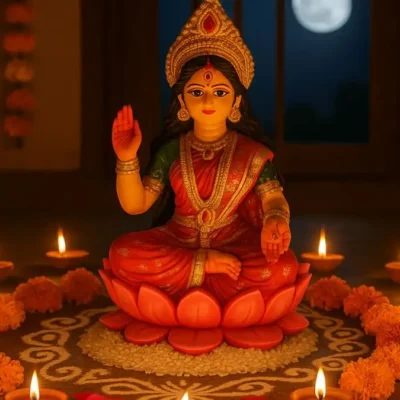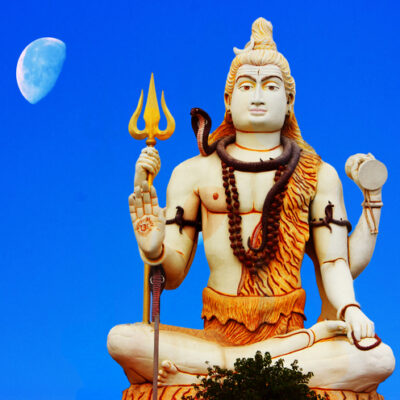Thiruvalangadu Sri Vadaranyeswarar Temple, Thiruvallur

Address
Thiruvalangadu Sri Vadaranyeswarar Temple, Thiruvalangadu Post, Thiruthani Taluk, Thiruvallur District, Tamil Nadu – 631 210. Tele: +91-044-27872074, 9952230906.
Diety
Vadaranyeswarar Amman: Vantarkulali,
Introduction
Thiruvalangadu is at a distance of about 17 kms from Thiruvallur en route Arakkonam. From Arakkonam also this place is about 17 kms. Thiruvalangadu has a railway station on the Chennai – Arakkonam rail route and the temple is about 4 kms away from the station. Other Paadal Petra Shivasthalams near Thiruvalangadu are – Ilambaiyangkottur (10 kms), Thiruvenpakkam (32 kms), Thakkolam (17 kms), Thiruvirkolam (20 kms) and Thirupachur (19 kms). Theertham (Holy water): Mukthi Theertham, Sentradu Theertham, Siva Kara Theertham Sthala Vriksham (Sacred Tree): Banyan tree
Puranic Significance
It is believed that originally this temple was constructed by the Chola and Pallava dynasties. This is a very ancient temple. The stone inscriptions available in this temple are from the periods of King Paranthaka Chola-I to the last king of Vijayanagaram. Earlier this village was called Pazhayanur and the place where this temple was located was called Alangadu. In the Devara Hymns, this place is mentioned as “Pazhayanur Alangadu”. This temple is under the administrative control of the Hindu Religious and Charitable Endowments Department of Government of Tamil Nadu (HR&CE). This temple is controlled by Thiruthani Murugan temple’s Eexcutive Officer/Joint Commissioner. According to the legend, in ancient times this region was a forest densely covered with banyan trees (Alamaram in Tamil). It is believed that a Swayambu Lingam was discovered under a banyan tree. Later a temple was constructed and the lord was named as “Sri Vadaranyeswarar” (Vadam meaning banyan tree, Aranyam meaning forest and the Eswar represents Lord Shiva). Since the celestial gods (Devas) are also believed to have worshiped the lord of this temple, he is also praised as “Sri Devarsingaperuman”. It is believed that Lord Murugan, Goddess Lakshmi and Saint Thirumular have worshiped Lord Shiva in this temple. Oordhuva Thandavam The legend is that two demons – Sumban and Nisumban had worshiped Lord Shiva to seek his blessings. Impressed by their rigorous penance, Lord Shiva gave them a blessing that every drop of their blood that fell on the ground would turn into a lingam. Having sought Lord Shiva’s blessings, these two demons started terrorising the celestial gods who in turn complained to Lord Shiva. Lord Shiva asked Goddess Parvathi to create “Bathra Kali” and this Kali was advised to go to Thiruvalangadu to destroy the demons. Kali fought with these two demons, defeated them and drank their blood. However, since she had drunk the blood of the demons, she started losing control of her senses and started acting like a demon herself. She started terrorising the celestial gods, who one again sought Lord Shiva’s intervention in this matter. To solve this problem, Lord Shiva and Goddess Parvathy came to this place. Kali who was not in control of her senses, started fighting with Lord Shiva. Lord Brahma, Lord Mahavishnu and Rishi Naradar intervened and made them accept a dance competition instead of a fight, which the duo agreed to perform. It is believed that the dance performance was witnessed by Goddess Parvathy, Rishi Naradar, Sage Munjikesa (Sage Anantha) and serpent Karkodakar. Lord Brahma and Lord Mahavishnu are believed to have provided music for their dance. Lord Shiva performed 17 types of dances which Kali also repeated. Finally, Lord Shiva played his “Oordhuva Thandavam” – a dance with very fast movements. Lord Shiva intentionally dropped his right earring on the ground, stood on his right leg, picked up the earring with the toe of his left leg and wore it again during the dance itself. Kali could not repeat this movement and admitted her defeat. Goddess Parvathy, who was astonished to watch this performance is praised here as “Arukilirunthu Viyantha Nayaki” (goddess who witnessed the spectacular dance performance). The lord here is praised as “Andamura Nimirntharuliya Nayanar” as he performed the Oordhuva Thandavam. Kali was very angry to accept her defeat. In order to appease her anger, Lord Shiva told her that he would be performing a pleasing dance – “Raksha dance” at Thiruvirkolam temple and she could have his dharisanam there. The Natarajar idol of this temple can be seen with its left leg almost touching the left ear. The idol of Goddess Sivakama Sundari can be seen with her face reflecting her astonishment. Neeli Story Another legend associated with this place is that of a lady called “Neeli”. It is believed that she was killed by her husband as he had suspected her of infidelity. After her death, she could not move on to her next birth and started roaming around this place in the form of a ghost. Incidentally, in his next birth, her husband was travelling through this place. Seeing her former husband, Neeli decided to seek revenge. She assumed the form of his present wife and wanted to go with him. He was surprised to see his wife here, he sensed that something was wrong and he refused to let her accompany him. Neeli went to the locals (velalars) and complained that her husband was abandoning her. The locals interfered and asked him to stay with her at a nearby place and travel with her the next morning. He tried explaining to them that she might not be his wife but they refused to his pleas. Instead they vouched for his safety by saying that if anything were to happen to him, they would also give up their lives. As soon as they went inside the house that the locals had given to them, Neeli took her original form of a ghost and killed him. In the morning when the locals found him dead, they decided to end of their lives and keep the promise that they made to him. The legend is that 70 velalars gave up their lives by self-immolation (Theekuliyal in Tamil). It is also believed that Lord Shiva gave salvation to all of them. It is interesting to note that the old Tamil proverb “Neeli Kanneer” (crocodile tears) originated from this story only. The hall where these velalars gave up their lives can still be seen near the Sakshibootheswarar temple in Pazhayanur (at a distance of about one kilometre from Thiruvalangadu temple). It is said that the heirs of those velalars still go to Thiruvalangadu temple for worship and for offering their services. Mantheeswarar Another legend is that Sani Bhagawan (Saturn) advised his son, Mantheeswarar who had accrued a sin (dosham) when a lizard fell on him, to go to Thiruvalangadu and worship Lord Shiva there. Pleased with his penance, Lord Shiva appeared before him and blessed him by absolving the sin.
Beliefs
This temple is considered to be a place where one can attain salvation. This is a parihara sthalam for Bharani Nakshathiram (star). Those who are born during the period of Bharani nakshathiram can perform special poojas here.This is an important place for Mantheeswarar pariharam and poojas can be performed on Saturdays. Mantheeswarar pariharam is performed for removal of obstacles in marriage proposals, to help married couples get the blessing of child birth and to seek relief from debts.Since Mantheeswarar is the son of Lord Sani (Saturn), poojas related to Sani doshams can also be performed here. Also, those aspiring for mastery in the art of dance can pray to Lord Vadaranyeswarar here and seek his blessings.
Special Features
Lord Natarajar’s five Sabhas This is one of the five places where Lord Shiva performed his cosmic dance – ‘Oorthava / Kali Thandavam’. The hall where he performed this dance is called “Rathina Sabhai (gem hall)”. The other four places are – Chidambaram – Por Sabhai (gold hall), Madurai – Velli Sabhai (silver hall), Tirunelveli – Thamira Sabhai (copper hall) and Kutralam- Chithira Sabhai (art/picture hall). Karaikal Ammaiyar: Lord Shiva’s dance here was also witnessed by one of his great devotees, Saint Karaikal Ammaiyar. She is also one of the 63 Nayanmars. It is said that she went to Mount Kailash by walking upside down on her head to see Lord Shiva. The lord addressed her as “Mother” (Amma in Tamil) and advised her to go to Thiruvalangadu to see his dance. She came to see the lord in this temple but a Shiva lingam started appearing wherever she put her foot. In order to give respect, she decided to again walk upside down on her head. She witnessed the dance performance of Lord Shiva, rendered her pathigam (hymn) and attained salvation in this temple itself. It is believed that her last resting place was at the feet of Lord Natarajar. Since her pathigams are prior to the Moovars Devaram, they are called “Mootha Thiru Pathigam”. Thiru Gnanasambanthar Another legend associated with this place is that since Karaikal Ammaiyar had walked on her head at this place, Saint Thiru Gnanasambanthar was afraid to set his foot on the soil. Not wanting to show any disrespect towards Karaikal Ammaiyar, he decided to stay in a nearby village and spent the night there without visiting this temple. However, Lord Shiva of this temple appeared in his dream and asked if he had forgotten to praise him. Next morning, he visited this temple and rendered a pathigam in which he mentioned about the “Neeli story” and God’s reminder to praise him. Deities in the temple Natarajar is praised here as “Rathina Sababathi Eswarar” and his consort, Sivakama Sundari is praised as “Sameesenambikai”. There are as many as sixty idols in this temple. Some of the idols and shrines are – Lords Vinayakar, Murugan with his consorts, Vijayaraghava Perumal with his consorts, Karaikkal Ammaiar, Agora Veerabathrar, Pancha Bootha lingams, Sahasra lingam, Kasi Viswanathar, Iyappan, Dakshinamurthy, Brahma, Durgai with Durga Parameswarar, Chandikeswarar, Sage Munjikesar, Karkodakar, Suryan, Chandran, Nalvars, Bathrakali Amman, Sapta Kanniyars and Bairavar. Idols of Mantheeswarar and the lingam installed and worshiped by him can also be seen.
Festivals
Thiruvadhirai in the Tamil month of Margazhi (December-January) is the most important festival of this temple. Almost all other festivals pertaining to Lord Shiva are observed in this temple.
Century/Period/Age
1000-2000 years old
Managed By
Hindu Religious and Charitable Endowments (HRCE)
Nearest Bus Station
Thiruvalangadu
Nearest Railway Station
Thiruvallur
Nearest Airport
Chennai










